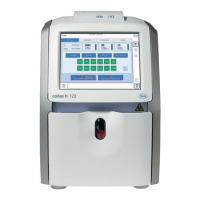Roche Diagnostics
116 Instructions for Use · Version 13.0
4 Theoretical foundations cobas b 123 POC system
Reference and critical values
Ca
2+
1.15–1.33 Serum, plasma
heparin
mmol/L 1.150–1.330 Tietz Textbook of Clinical
Chemistry and Molecular
Diagnostics, 5th edition 2012, p.
2137
Hct 36–48 (Caucasian female)
40–53 (Caucasian male)
Whole blood,
Capillary blood
%
36–53 (all)
(3)
36–48 (female)
40–53 (male)
Lothar Thomas, Labor und
Diagnose, 8. Auflage, p. 840
tHb 11.5–16.0 (female adult)
13.5–17.8 (male adult)
Capillary blood g/dL
11.5–17.8 (all)
(2)
11.5–16.0 (female)
13.5–17.8 (male)
Lothar Thomas, Labor und
Diagnose, 8. Auflage, p. 827
SO
2
/O
2
94–98 Whole blood arterial % 94.0–98.0 Tietz Textbook of Clinical
Chemistry and Molecular
Diagnostics, 5th edition 2012, p.
2162
O
2
Hb 94.0–98.0 Arterial blood % 94.0–98.0 Lothar Thomas, Labor und
Diagnose, 8. Auflage, p. 535
HHb <3 % 0.0–2.9 Kenneth A. Wyka, Paul J.
Mathews, John Rutkowski:
Foundations of respiratory care, p.
153
COHb 3 nonsmoker Whole blood
heparin
%
0.0–3.0
(4)
Lothar Thomas, Labor und
Diagnose, 8. Auflage, p. 848
MetHb 0.04–1.52 Whole blood
heparin
%
0.0–1.5
(5)
Tietz Textbook of Clinical
Chemistry and Molecular
Diagnostics, 5th edition 2012, p.
2160
Bili 2.0–6.0 (0–1 d full term)
6.0–10.0 (1–2 d full term)
4.0–8.0 (3–5 d full term)
Serum mg/dL
3.0–10.0 (all)
(6)
3.0–10.0
(newborn)
(6)
6.0–10.0 (2nd day)
4.0–8.0 ( 1 year)
Tietz Textbook of Clinical
Chemistry and Molecular
Diagnostics, 5th edition 2012, p.
2136
Glu 4.1–5.6 Serum mmol/L 4.1–5.6 Tietz Textbook of Clinical
Chemistry and Molecular
Diagnostics, 5th edition 2012, p.
2149
Lac <1.8 Arterial whole blood
plasma, bed rest
mmol/L 1.0–1.8 Lothar Thomas, Labor und
Diagnose, 8. Auflage, p. 336
(1) By default, the reference/normal ranges are implemented into the instrument software for unspecified: gender, age and sample type. All exceptions
to this general approach are clearly stated. Note that the instrument software does not allow a reference range beyond the specified measuring range.
(2) Refers to the lower limit for females to the upper limit of males.
(3) Refers to the lower limit for Caucasian females to the upper limit of Caucasian males.
(4) Upper limit refers to nonsmokers.
(5) Default value rounded to one tenth place value.
(6) The proposed default reference range for newborns (3.0 - 10.0) mg/dL refers to the lower level of the specified bilirubin measuring range to the upper
level for 1-2 days old full term patients. This lower limit is truncated due to the specified bilirubin measuring range. The same default reference range
for newborn is applied to unspecified ages (all).
Parameter Normal range Sample matrix Unit Displayed/printed
default range
(1)
Source
Table 4-3 Reference/normal ranges

